Scientific happenings, big and small, on this day in history
But first, today’s quiz:
The answer may seem obvious, but don’t be fooled – it’s not what you think. On this day in 1886, the first earthquake on record with significant human consequence (over 100 deaths) took place. In what U.S. state did it occur? Just to confirm, it’s NOT California. You can discover the answer at the end of this article.
Now on to other events:
EVENTS
1895
Design of the Zeppelin patented
In 1895, Count Ferdinand von Zeppelin patented in Germany his invention of the rigid airship, known as the Zeppelin. The most important feature of Zeppelin's design is a rigid metal alloy skeleton, made of rings and longitudinal girders. The advantage of this concept is that they can be built much larger than non-rigid airships (which rely on a slight overpressure within the single gasbag to maintain their shape). This enables them to lift heavier loads and they can be equipped with more numerous and powerful engines.
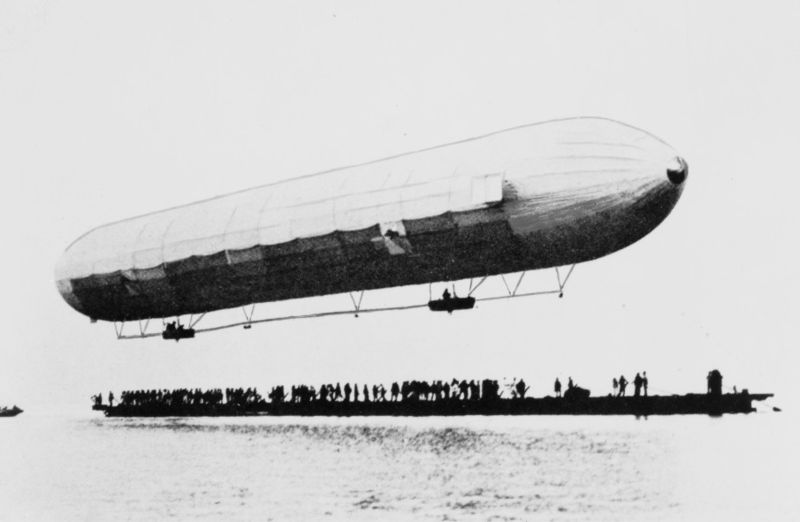
Construction of the first Zeppelin began in 1899 in a floating assembly hall on the Bodensee. This location was intended to facilitate the difficult launching procedure, as the hall could easily be aligned with the wind. The prototype airship LZ 1 had a length of 420 ft, was driven by two 14.2 horsepower engines and was controlled in pitch by moving a weight between its two nacelles.
The first Zeppelin flight occurred on 2 July 1900 over the Bodensee. It lasted only 18 minutes before LZ 1 was forced to land on the lake after the winding mechanism for the balancing weight broke. After it was placed back in the hangar an apparatus used to suspend it broke. Upon repair, rigid airship technology proved its potential in subsequent flights beating the previously set airship velocity record. Despite this performance, the shareholders declined to invest more money, and so the company was liquidated, with Count von Zeppelin purchasing the ship and equipment. The Count wished to continue experimenting, but he eventually dismantled the ship in 1901.
It was largely due to support by aviation enthusiasts that von Zeppelin's idea got a second chance. His third ship, LZ 3, became the first truly successful Zeppelin, which by 1908 had traveled 2,733 miles in total in the course of 45 flights. The technology then interested the German military, who bought LZ 3 and redesignated it Z 1.
Prior to World War I, a total of 21 Zeppelin airships (LZ 5 to LZ 25) were manufactured. Zeppelins were used as bombers during World War I, without notable success. At the beginning of the conflict the German command had high hopes for the craft, as they appeared to have compelling advantages over contemporary aircraft - they were almost as fast, carried many more guns, and had a greater bomb load capacity and enormously greater range and endurance. However, their great weakness was their vulnerability to gunfire.
The main use of the craft was in reconnaissance over the North Sea and the Baltic, where the admirable endurance of the craft led German warships to a number of Allied vessels. Zeppelin patrolling had priority over any other airship activity. During the entire war around 1,200 scouting flights were made. During 1915 the German Navy had some 15 Zeppelins in commission and was able to have two or more patrolling continuously at any one time, almost regardless of weather. They kept the British ships from approaching Germany, spotted when and where the British were laying sea-mines, and later aided in the destruction of those mines. Zeppelins would sometimes land on the sea surface next to a minesweeper, bring aboard an officer and show him the lay of the mines.
The German defeat in the war also marked the end of German military dirigibles, as the victorious Allies demanded a complete disarmament of German air forces and delivery of the remaining airships as war reparations.
Count von Zeppelin had died in 1917, before the end of the war. Dr. Hugo Eckener, a man who envisioned dirigibles as vessels of peace rather than warfare, took command of the Zeppelin business. Eckener’s first break in this new venture occurred when he managed to acquire an order for an American dirigible in 1924. This newest dirigible, designed LZ 126, used all the expertise accumulated over the years and was the company’s best Zeppelin so far, which took off for a first test flight on 27 August 1924. It was delivered to the United States after a transatlantic flight under Eckener’s command. The ship completed her 5,000 mile voyage without any difficulties in 81 hours and two minutes. American crowds enthusiastically celebrated the arrival, and President Calvin Coolidge invited Dr. Eckener and his crew to the White House, calling the new Zeppelin an "angel of peace". Under its new designation, ZR-3 USS Los Angeles became the most successful American airship. She operated reliably for eight years until being retired in 1932 for economic reasons and dismantled in August 1940.
Following 1933, the establishment of the Nazi dictatorship in Germany began to overshadow the Zeppelin business. The Nazis were not interested in Eckener's ideals of peacefully connecting people; they also knew very well dirigibles would be useless in combat and thus chose to focus on heavier-than-air technology. On the other hand, they were eager to exploit the popularity of the airships for propaganda. As Eckener refused to cooperate, the Nazi Air minister formed a new airline in 1935, which took over operation of airship flights. Zeppelins would now prominently display the Nazi swastika on their fins and occasionally tour Germany to indoctrinate the people with march music and Nazi propaganda speeches from the air.
On 4 March 1936, LZ 129 Hindenburg made her first flight. The Hindenburg was the largest airship ever built. However, in the new political situation, Eckener had not obtained the helium to inflate it due to a military embargo; only the United States possessed the rare gas in usable quantities. So, in what ultimately proved a fatal decision, the Hindenburg was filled with flammable hydrogen.
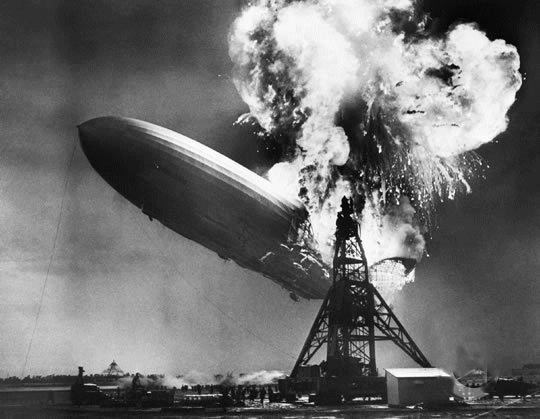
On 6 May 1937, while landing in Lakehurst after a transatlantic flight, in front of thousands of spectators, the tail of the ship caught fire, and within seconds, the Hindenburg burst into flames, killing 35 of the 97 people on board and one member of the ground crew. The actual cause of the fire has not been definitively determined; it is likely that a combination of leaking hydrogen from a torn gas bag, the vibrations caused by a swift rotation for a quicker landing to have started static electricity in the duralumin alloy skeleton and a flammable outer coating similar to rocket fuel accounted for the fact that the fire spread from its starting point in the tail to engulf the entire airship so rapidly (34 seconds).
Whatever caused the disaster, it marked the end of the dirigible era -- although the end was more due to politics and the upcoming war, not the wreck itself.
http://en.wikipedia.org/wiki/Zeppelin
1910
First U.S. airplane flight over water
On the afternoon of August 31, 1910, aviation pioneer Glenn Curtiss established a record for flying over water when he landed his biplane on the beach at Cedar Point in Sandusky, Ohio. He had taken off from Euclid Beach in Cleveland, Ohio about an hour and fifteen minutes earlier -- flying over Lake Erie, parallel to the shore. His return trip to Cleveland the next day added to his record. Thousands flocked to see the flight at its take-off and landing points. Many more positioned themselves on the shore along the route, hoping to spot Curtiss and his flying machine in the air.
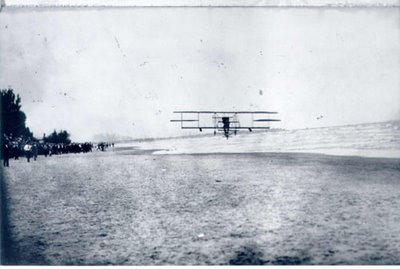
Part of Curtiss' inspiration for attempting the flight to Cedar Point was a prize of $15,000 (an equivalent value of more than $300,000 today) offered by Cedar Point Manager George Boeckling, with a $5,000 bonus if the flight was completed in less than one hour. The people of Sandusky were as excited about the prospect of the record-breaking flight as Curtiss. Spotters were assigned along the route to telephone information about the airplane's progress; boats to Cedar Point were to run as frequently as possible, to bring people from downtown Sandusky to the beach; many businesses in Sandusky planned to close for the day, so that their employees may watch the arrival; men with megaphones were assigned to broadcast updates to the spectators on the beach.
In Sandusky, it was arranged that the fire whistle, at the Meigs Street Water Works, was to sound three times upon news of Curtiss' departure from Cleveland (where it was said that 100,000 people watched his flight). It did so at around 1:15 that afternoon. Sandusky residents raced down the streets to the boat landing to await Curtiss’ arrival. At an altitude between 400 and 500 feet, the 70 mile trip took 78 minutes nonstop. When he landed at Cedar point, he was greeted on the beach by thousands of local spectators, and by Boeckling -- who later that day gave a banquet in his honor.
http://sanduskyhistory.blogspot.com/2007/08/glenn-curtiss-record-setting...
1968
First simultaneous multi-organ transplant
In 1968, Dr. Michael E. DeBakey of Houston led the first simultaneous multi-organ transplant from one donor to four recipients. Two kidneys, one lobe of a lung and the heart were removed from a 20-yr-old woman who died from a gunshot. The organs were transplanted into four men at Methodist Hospital, Houston, Texas. The surgery, which began within eight hours of the woman's death, was performed by five teams totaling more than 60 physicians, nurses and support persons. The heart, lobe of a lung, and two kidneys were transplanted into men aged 50, 39, 41 and 22 respectively.
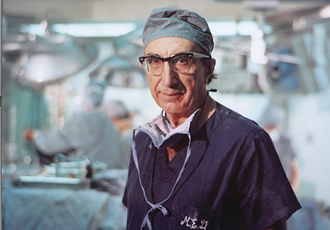
DeBakey’s many contributions include inventing, while still a medical student, a pump for blood transfusions that was used in the first successful open-heart operation, performing the first successful coronary bypass surgery and helping establish the concept of Mobile Army Surgical Hospitals or M.A.S.H. units.
DeBakey was a renowned cardiovascular surgeon, who counted among his patients Richard Nixon, Lyndon B. Johnson, John F. Kennedy, Russia’s Boris Yeltzin and Jordan’s King Hussein. President Lyndon Johnson named DeBakey chair of the President’s Commission on Heart Disease, Cancer and Stroke in 1964. Johnson also honored DeBakey with the Presidential Medal of Freedom in 1969, and in 1985 President Ronald Reagan conferred on him the National Medal of Science. He continued to perform heart surgery until his 90s and this past spring received the Congressional Gold Medal, the highest civilian honor awarded by Congress, at a ceremony in the rotunda of the U.S. Capitol.
DeBakey passed away just last month on July 11th. This upcoming September 7th would have marked his 100th birthday.
http://tulane.edu/news/newwave/071508_debakey.cfm
1971
First vehicle driven on the moon
Dave Scott and James Irwin, who descended to the moon in the Apollo 15 Lunar Excursion Module "Falcon," were the eighth and ninth men respectively to walk on the lunar surface. Scott was mission commander. What made their trip different was that this week, on Aug. 31, 1971, Scott became the first person to drive a vehicle on the moon. The car, the Lunar Roving Vehicle (LVR), was simply called the "Moon Rover."
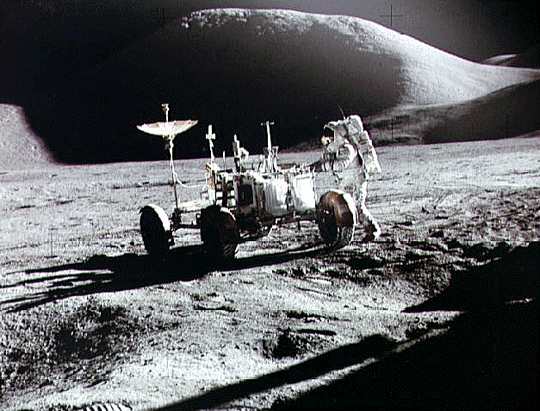
They didn't exactly speed off to their job site during a rush hour where they were the only vehicle, but more meandered across a boulder-strewn field. After all, the vehicle's top speed was just 8 to 10 mph, which it could maintain for 36 miles provided Scott kept the car going straight and didn't veer off somewhere.
LRVs were used for greater surface mobility during the Apollo J-class missions: (Apollo 15, Apollo 16, and Apollo 17). This greatly expanded the range of the lunar explorers. Previous teams of astronauts were restricted to short walking distances around the landing site due to the bulky space suit equipment required to sustain life in the lunar environment.
The LRV was developed in only 17 months and yet performed all its functions on the Moon with no major anomalies. Harrison Schmitt of Apollo 17 said, "....the Lunar Rover proved to be the reliable, safe and flexible lunar exploration vehicle we expected it to be. Without it, the major scientific discoveries of Apollo 15, 16, and 17 would not have been possible; and our current understanding of lunar evolution would not have been possible."
On the day of his historic drive, Scott said, "Man must explore, and this is exploration at its greatest."
http://www.alamogordonews.com/features/ci_10345949
http://en.wikipedia.org/wiki/Lunar_rover
BIRTHS
1912
Robert F. Borkenstein (Born Aug. 31, 1912; died Aug. 10, 2002)
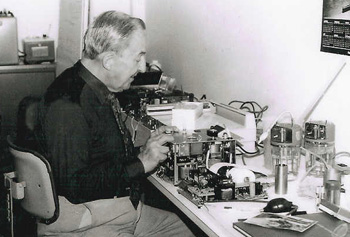
Robert Borkenstein revolutionized enforcement of drunken driving laws by inventing the Breathalyzer to measure alcohol in the blood.
He started working for the Indiana state police in 1936, did early research on the development of the lie detector and rose to captain in charge of laboratory services.
He collaborated with Dr. R. N. Harger of the Indiana School of Medicine to develop the Drunkometer, one of the first instruments that accurately measured blood alcohol. This led to Mr. Borkenstein's independent invention of the smaller, easier-to-use Breathalyzer in 1953.
The Breathalyzer is a portable device that can determine whether the person being tested is legally drunk. It measures the proportion of alcohol vapors in exhaled air, a proportion that reflects the content of alcohol in the blood.
Before widespread use of the device, police officers investigating an accident or noticing a weaving car looked for symptoms like a flushed face, slurred speech and bloodshot eyes. If the suspect then went to sleep in the police station, they might have sufficient basis for charges.
Getting a conviction was harder still. Defense lawyers might say the suspect had been staggering because of the long hours he worked, and bring in friends to say he had had no more than two beers. The defendant might maintain that his eyes had been red as a result of allergies.
But the Breathalyzer provided scientific evidence of intoxication. The ratio of breath alcohol to blood alcohol is 2,100 to 1, meaning that 2,100 milliliters of exhaled air will contain the same amount of alcohol as one milliliter of blood.
For many years the typical legal standard for drunkenness across the United States was 0.10, meaning 0.10 gram of alcohol per 100 milliliters of blood. Many states have now adopted 0.08 as a standard, and the federal government has pushed others to do so.
http://query.nytimes.com/gst/fullpage.html?res=9D01E3DC123DF934A2575BC0A...
1913
Sir Bernard Lovell (Born Aug. 31, 1913 - )
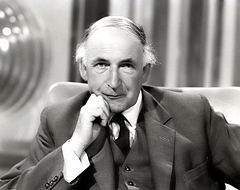
Sir Alfred Charles Bernard Lovell was an English radio astronomer who established and directed (from 1951-1981) Jodrell Bank Experimental Station, Cheshire, England, with (then) the world's largest steerable radio telescope – which is now named after him.
When bouncing radio waves off cosmic-ray showers and detecting the echoes, Lovell observed many transient (short-term) echoes, which he concluded were from meteor trails. Carefully choosing a known comet with desirable characteristics, Lovell, in October 1946, directed his radar equipment skyward and proved beyond question that the transient meteor-trail echoes he had observed earlier were signals bounced off the tails of comets. His meteor studies lead to the discoveries that meteors orbited within the solar system (and did not come from beyond it), and that science was underestimating the number and intensity of daytime meteor showers.
Technical disturbing effects from the city of Manchester during this work convinced Lovell of the need for a country location, and he received permission to establish the Jodrell Bank Laboratory in Cheshire, of which he became director in 1951. That same year, a special academic chair was created for him at Manchester University: he became professor of radio astronomy. Using Michelson stellar interferometric techniques, Lovell proved that radio sources are constantly emitting "point sources" of energy, and not, as had been previously thought, diffuse interstellar clouds of ionized hydrogen. The previously detected fluctuations in radio sources were shown to be imposed on them by the earth's ionosphere, in much the same way as the earth's atmosphere causes the twinkling of a star at optical wavelengths.
In 1952 Lovell convinced the British government and the Nuffield Foundation to jointly finance the construction of the largest, completely steerable radio telescope in the world with a parabolic dish that would be able to receive radio waves as short as 30 centimeters. The telescope was completed in 1957 at the Jodrell Bank Observatory.
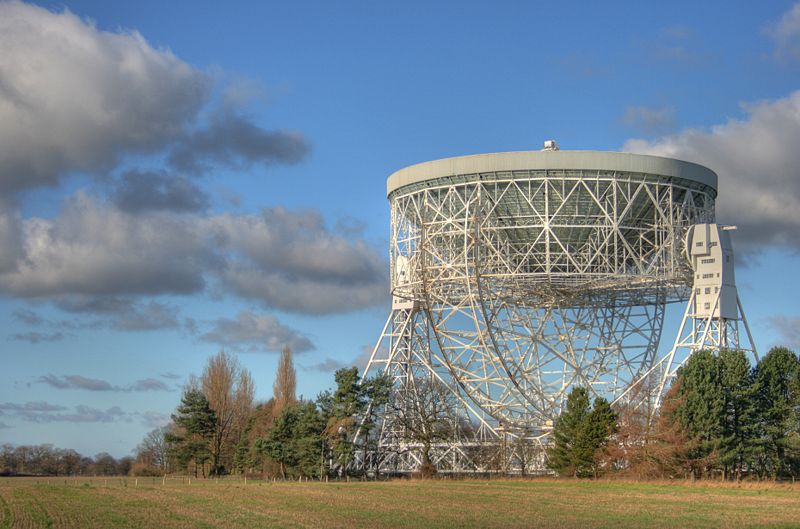
As it developed, the huge telescope, 250 feet in diameter, was completed in time to track the first artificial earth satellite, the Russian Sputnik, in October 1957. Communications work and future trackings, including that of the American manned moon landing in July 1969, gained for Lovell and Jodrell Bank a great deal of publicity. His work in radio astronomy led to the 1963 discovery of quasars and the development of knowledge about pulsars and red dwarf stars.
http://www.answers.com/topic/bernard-lovell
And the answer to today’s quiz?
The first U.S. earthquake on record with significant human consequence that took place on this day in 1886, hit Charleston, South Carolina.
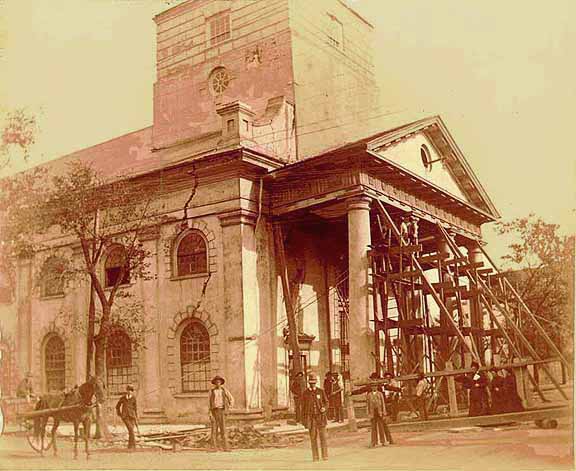
It occurred at 9:50 p.m. and lasted just under a minute. Major damage occurred as far away as Tybee Island, Georgia (over 60 miles away) and structural damage was reported several hundred miles from Charleston (including central Alabama, central Ohio, eastern Kentucky, southern Virginia, and western West Virginia). It was felt as far away as Boston to the North, Chicago and Milwaukee to the Northwest, as far West as New Orleans, as far South as Cuba, and as far East as Bermuda.
The earthquake is estimated to be between 6.6 and 7.3 on the Richter scale. More than 300 aftershocks of the 1886 earthquake occurred within thirty-five years. Minor earthquake activity that still continues in the area today may be a continuation of aftershocks. Very little to no historical earthquake activity occurred in the Charleston area prior to the 1886 event, which is unusual for any seismic area. This may have contributed to the severity of the tremor.
The 1886 earthquake is a heavily studied example of an intraplate earthquake. The earthquake is believed to have occurred on faults formed during the break-up of Pangea. Similar faults are found all along the east coast of North America. It is thought that such ancient faults remain active from forces exerted on them by present-day motions of the North American Plate. The exact mechanisms of intraplate earthquakes are a subject of much ongoing research.
http://www.eas.slu.edu/Earthquake_Center/1886EQ/
http://en.wikipedia.org/wiki/Charleston_earthquake






Comments